1.1 13Defining Unemployment
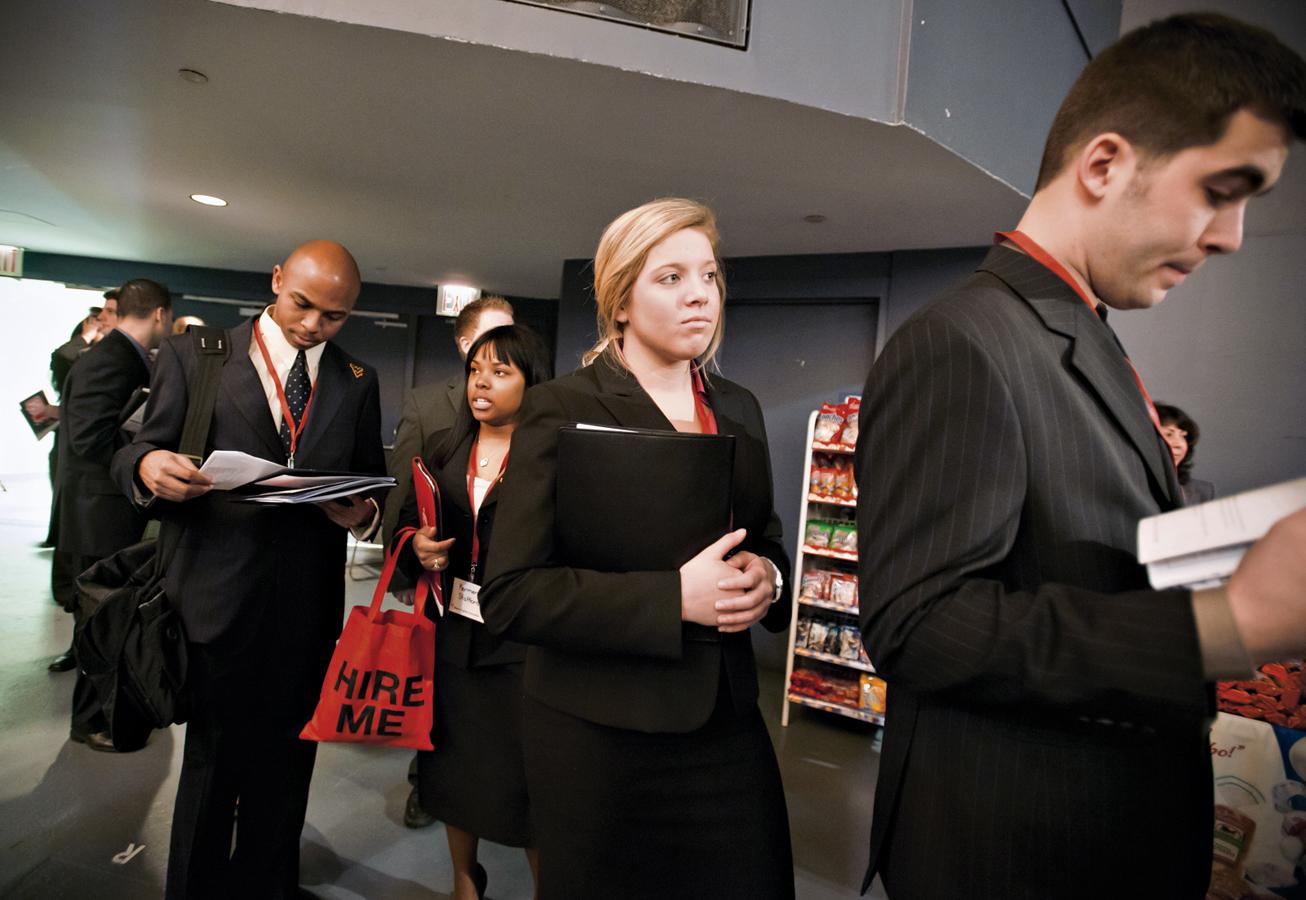
WHAT YOU WILL LEARN
 How unemployment is measured
How unemployment is measured
 How the unemployment rate is calculated
How the unemployment rate is calculated
 The significance of the unemployment rate for the economy
The significance of the unemployment rate for the economy
 The relationship between the unemployment rate and economic growth
The relationship between the unemployment rate and economic growth
The Unemployment Rate
One of the most important issues in both the 2008 and 2012 presidential elections was the high unemployment rate. Figure 13-1 shows the U.S. unemployment rate from 1948 to 2013. As you can see, the labor market hit a difficult patch starting in mid-
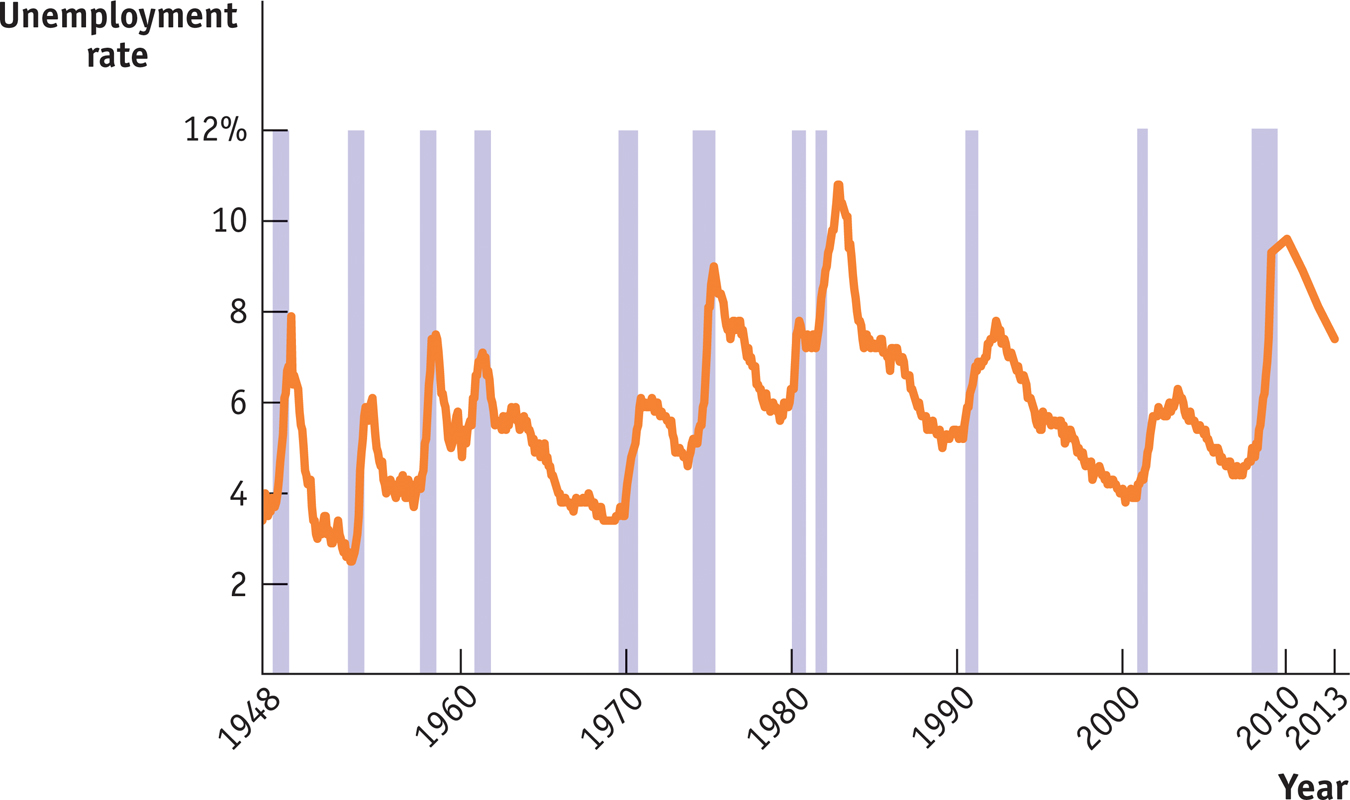
Defining and Measuring Unemployment
Employed people are currently holding a job in the economy, either full time or part time.
It’s easy to define employment: you’re employed if and only if you have a job.
Unemployment, however, is a more subtle concept. Just because a person isn’t working doesn’t mean that we consider that person unemployed. For example, in November 2013 there were 42 million retired workers in the United States receiving Social Security checks. Most of them were probably happy that they were no longer working, so we wouldn’t consider someone who has settled into a comfortable, well-
Unemployed people are actively looking for work but aren’t currently employed.
The U.S. Census Bureau, the federal agency that collects data on unemployment, considers the unemployed to be those who are “jobless, looking for jobs, and available for work.” Retired people don’t count because they aren’t looking for jobs; the disabled don’t count because they aren’t available for work. More specifically, an individual is considered unemployed if he or she doesn’t currently have a job and has been actively seeking a job during the past four weeks. So the unemployed are people who are actively looking for work but aren’t currently employed.
The labor force is equal to the sum of the employed and the unemployed.
The labor force participation rate is the percentage of the population aged 16 or older that is in the labor force.
A country’s labor force is the sum of the employed and the unemployed—

The unemployment rate is the percentage of the total number of people in the labor force who are unemployed.
The unemployment rate, defined as the percentage of the total number of people in the labor force who are unemployed, is calculated as follows:

To estimate the numbers that go into calculating the unemployment rate, the U.S. Census Bureau carries out a monthly survey called the Current Population Survey, which involves interviewing a random sample of 60,000 American families. People are asked whether they are currently employed. If they are not employed, they are asked whether they have been looking for a job during the past four weeks. The results are then scaled up, using estimates of the total population, to estimate the total number of employed and unemployed Americans.
The Significance of the Unemployment Rate

In general, the unemployment rate is a good indicator of how easy or difficult it is to find a job given the current state of the economy. When the unemployment rate is low, nearly everyone who wants a job can find one. In 2000, when the unemployment rate averaged 4%, jobs were so abundant that employers spoke of a “mirror test” for getting a job: if you were breathing (therefore, your breath would fog a mirror), you could find work. By contrast, in 2009, the unemployment rate in 17 states rose to over 10% (over 15% in Michigan). Even in 2013, with the unemployment rate averaging 7.4%, it was difficult to find work. More than three times as many Americans were looking for work as there were job openings.
Although the unemployment rate is a good indicator of current labor market conditions, it is not a perfect measure. It has been known to overstate or understate the true level of unemployment.
How The Unemployment Rate Can Overstate The True Level Of UnemploymentIf you are searching for work, it’s normal to take at least a few weeks to find a suitable job. Yet a worker who is quite confident of finding a job, but has not yet accepted a position, is counted as unemployed. As a consequence, the unemployment rate never falls to zero, even in boom times when jobs are plentiful. Even in the buoyant labor market of 2000, when it was easy to find work, the unemployment rate was still 4%. Later, we’ll discuss in greater depth the reasons that measured unemployment persists even when jobs are abundant.
How The Unemployment Rate Can Understate The True Level Of UnemploymentFrequently, people who would like to work but aren’t working still don’t get counted as unemployed. In particular, an individual who has given up looking for a job for the time being because there are no jobs available isn’t counted as unemployed because he or she has not been searching for a job during the previous four weeks.
Discouraged workers are nonworking people who are capable of working but have given up looking for a job due to the state of the job market.
Individuals who want to work but aren’t currently searching because they see little prospect of finding a job given the state of the job market are known as discouraged workers. Because it does not count discouraged workers, the measured unemployment rate may understate the percentage of people who want to work but are unable to find jobs.
Marginally attached workers would like to be employed and have looked for a job in the recent past but are not currently looking for work.
Discouraged workers are part of a larger group known as marginally attached workers. These are people who say they would like to have a job and have looked for work in the recent past but are not currently looking for work. They are also not included when calculating the unemployment rate.
The underemployed are people who work part time because they cannot find full-
Finally, another category of workers who are frustrated in their ability to find work but aren’t counted as unemployed are the underemployed: workers who would like to find full-
The Bureau of Labor Statistics is the federal agency that calculates the official unemployment rate. It also calculates broader “measures of labor underutilization” that include the three categories of frustrated workers. Figure 13-2 shows what happens to the measured unemployment rate once marginally attached workers (including discouraged workers) and the underemployed are counted.
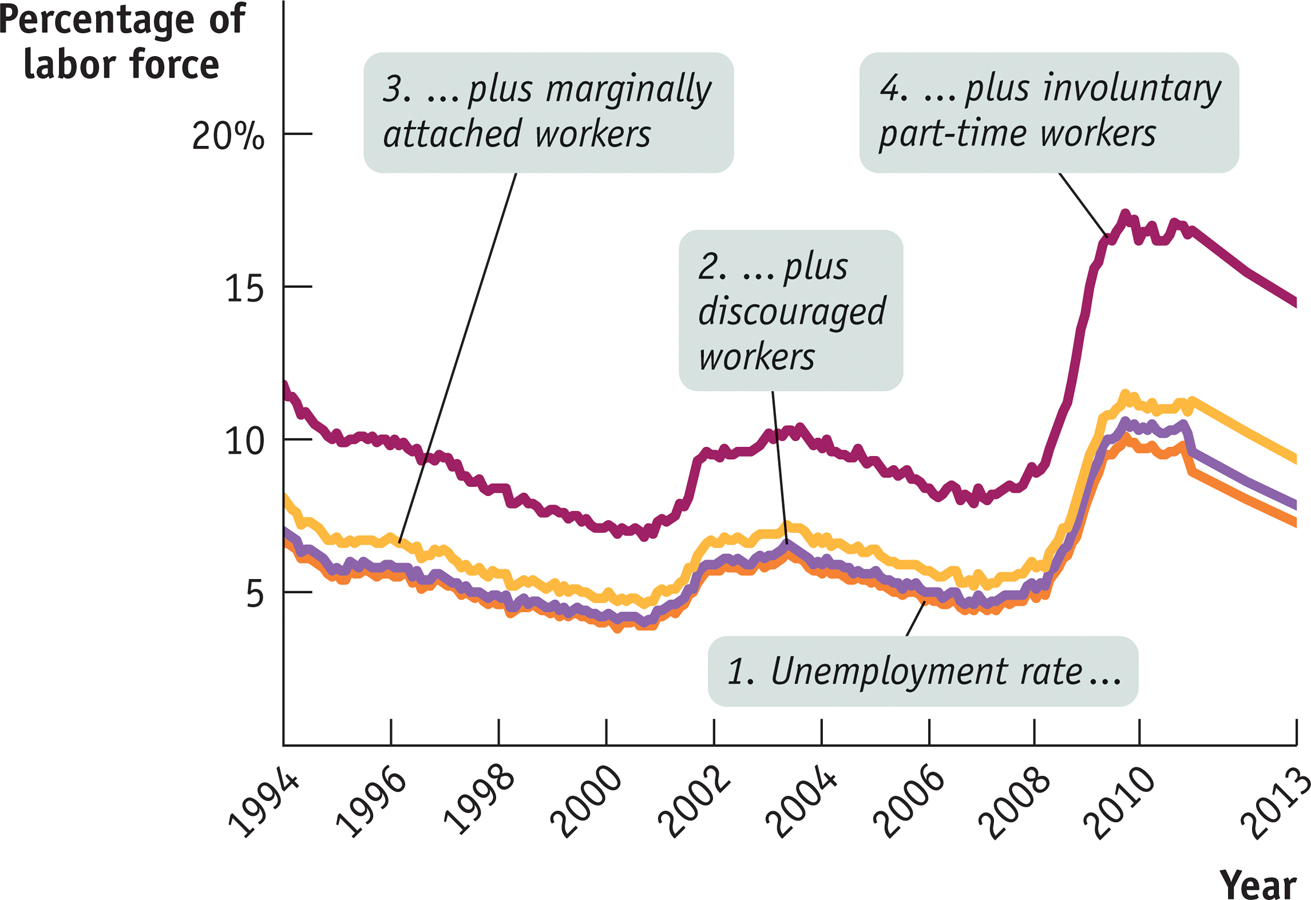

The broadest measure of unemployment and underemployment, known as U6, is the sum of these three measures plus the unemployed; it is substantially higher than the rate usually quoted by the news media. But U6 and the unemployment rate move very much in parallel, so changes in the unemployment rate remain a good guide to what’s happening in the overall labor market.
Finally, it’s important to realize that the unemployment rate varies greatly among demographic groups. Other things equal, jobs are generally easier to find for more experienced workers and for workers during their “prime” working years, from ages 25 to 54. For younger workers, as well as workers nearing retirement age, jobs are typically harder to find, other things equal.
Figure 13-3 shows unemployment rates for different groups in December 2007, when the overall unemployment rate of 5.0% was low by historical standards. As you can see, in December 2007 the unemployment rate for African-
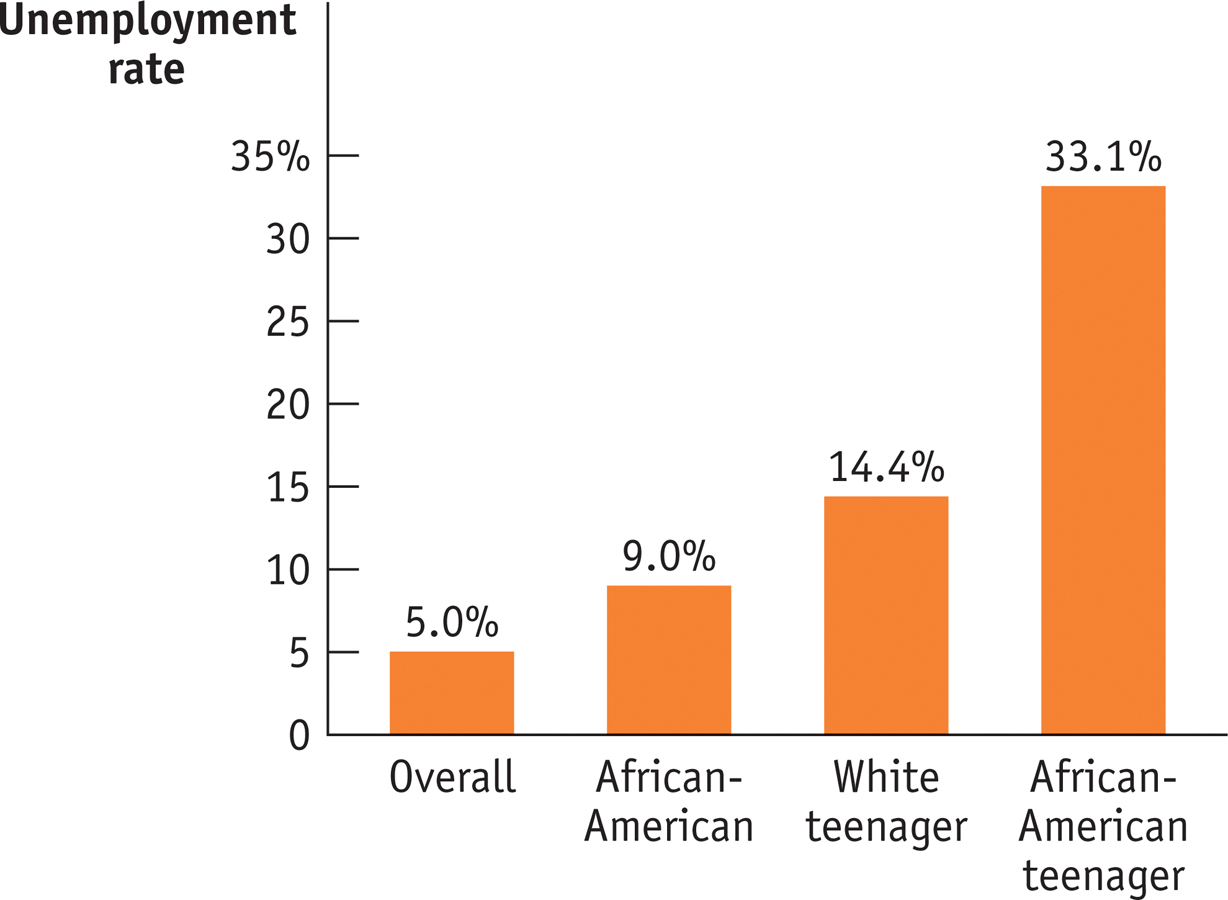
So although the unemployment rate is not an exact, literal measure of the percentage of people unable to find jobs, it is a good indicator of overall labor market conditions. The ups and downs of the unemployment rate closely reflect economic changes that have a significant impact on people’s lives. Let’s turn now to the causes of these fluctuations.
Growth and Unemployment
Compared to Figure 13-1, Figure 13-4 shows the U.S. unemployment rate over a somewhat shorter period, the 35 years from 1978 to 2013. The shaded bars represent periods of recession. As you can see, during every recession, without exception, the unemployment rate rose. The severe recession of 2007–

Correspondingly, during periods of economic expansion the unemployment rate usually falls. The long economic expansion of the 1990s eventually brought the unemployment rate below 4%, and the expansion of the mid-
Figure 13-5 is a scatter diagram showing U.S. data for the period from 1949 to 2012. The horizontal axis measures the annual rate of growth in real GDP—
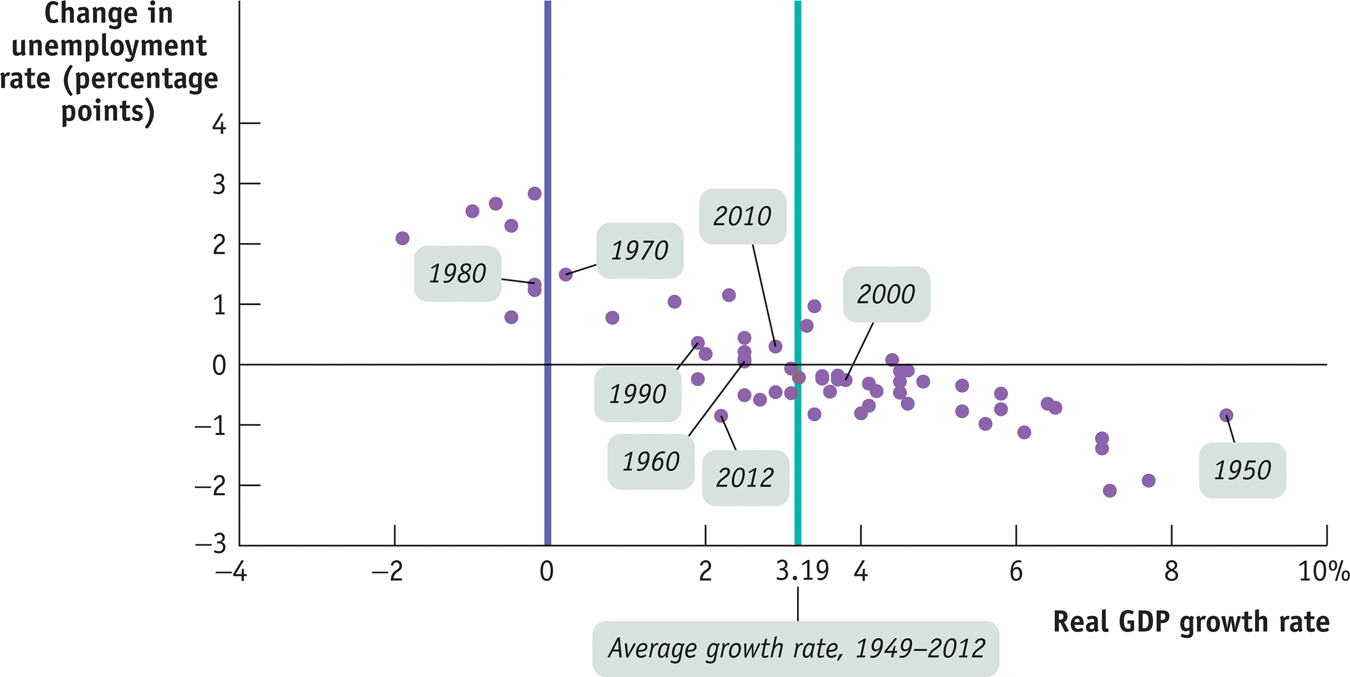
The downward trend of the scatter points in Figure 13-5 shows that there is a generally strong negative relationship between growth in the economy and the rate of unemployment. Years of high growth in real GDP were also years in which the unemployment rate fell, and years of low or negative growth in real GDP were years in which the unemployment rate rose.
The green vertical line in Figure 13-5 at the value of 3.19% indicates the average growth rate of real GDP over the period from 1949 to 2012. Points lying to the right of the vertical line are years of above-
A jobless recovery is a period in which the GDP growth rate is positive but the unemployment rate is still rising.
A period in which GDP is growing at a below-
But true recessions, periods when real GDP falls, are especially painful for workers. As illustrated by the points to the left of the purple vertical line in Figure 13-5 (representing years in which the real GDP growth rate is negative), falling real GDP is always associated with a rising rate of unemployment, causing a great deal of hardship to families.
FAILURE TO LAUNCH

In March 2010, when the U.S. job situation was near its worst, the Harvard Law Record published a brief note titled “Unemployed law student will work for $160K plus benefits.” In a self-
The answer, of course, is that it wasn’t about the résumé—it was about the economy. Times of high unemployment are especially hard on new graduates, who often find it hard to get any kind of full-
How bad was it in March 2010, around the time that note was written? Researchers at the San Francisco Fed analyzed the employment experience of college graduates, ages 21–

Although the overall unemployment rate for college graduates 25 and older, even at its peak, was only about 5%, unemployment among recent graduates aged 21–
The situation is improving, but slowly: by the end of 2010, 74% of recent graduates had full-
13
Solutions appear at the back of the book.
Check Your Understanding
Suppose that employment websites enable job-
seekers to find suitable jobs more quickly. What effect will this have on the unemployment rate over time? Also suppose that these websites encourage job- seekers who had given up their searches to begin looking again. What effect will this have on the unemployment rate? The advent of websites that enable job-seekers to find jobs more quickly will reduce the unemployment rate over time. However, websites that induce discouraged workers to begin actively looking for work again will lead to an increase in the unemployment rate over time.In which of the following cases would the worker be counted as unemployed? Explain.
-
a. Rosa, an older worker, has been laid off and gave up looking for work months ago.
Not counted as unemployed because not actively looking for work, but counted in broader measures of labor underutilization as a discouraged worker. -
b. Anthony, a schoolteacher, is not working during his three-
month summer break. Not counted as unemployed—considered employed because the teacher has a job. -
c. Grace, an investment banker, has been laid off and is currently searching for another position.
Unemployed: not working, actively looking for work. -
d. Sergio, a classically trained musician, can only find work playing for local parties.
Not unemployed, but underemployed: working part-time for economic reasons. Counted in broader measures of labor underutilization. -
e. Natasha, a graduate student, went back to school because jobs were scarce.
Not unemployed, but considered “marginally attached.” Counted in broader measures of labor underutilization.
-
Which of the following are consistent with the observed relationship between growth in real GDP and changes in the unemployment rate? Which are not?
-
a. A rise in the unemployment rate accompanies a fall in real GDP.
-
b. An exceptionally strong business recovery is associated with a greater percentage of the labor force being employed.
-
c. Negative real GDP growth is associated with a fall in the unemployment rate.
Items (a) and (b) are consistent with the observed relationship between growth in GDP and changes in the unemployment rate. Item (c) is not.
-
Multiple-
Question
To be considered unemployed, a person must
I. not be working.
II. be actively seeking a job.
III. be available for work.A. B. C. D. E.
Use the information for a hypothetical economy presented in the following table to answer questions 2, 3, and 4.

Question
What is the labor force participation rate?
A. B. C. D. E. Question
How many people are unemployed?
A. B. C. D. E. Question
What is the unemployment rate?
A. B. C. D. E. Question
The unemployment problem in an economy may be understated by the unemployment rate due to
A. B. C. D. E.
Critical-
What is the labor market classification for each of the following individuals? Be as specific as possible, and explain your answer.
Julie has a graduate degree in mechanical engineering. She works full-
time mowing lawns. Employed (underemployed); she is not working up to her full potential.Jeff was laid off from his previous job. He would very much like to work at any job, but, after looking for work for a year, has stopped looking for work.
Not in the labor force (discouraged). Once a worker stops actively seeking work, he or she falls out of the labor force.Ian is working 25 hours per week at a bookstore, and has no desire to work full time.
Employed (part-time); individuals are classified as employed if they work full or part time.Raj has decided to take a year off from work to stay home with his daughter.
Not in the labor force; he is not actively seeking employment.